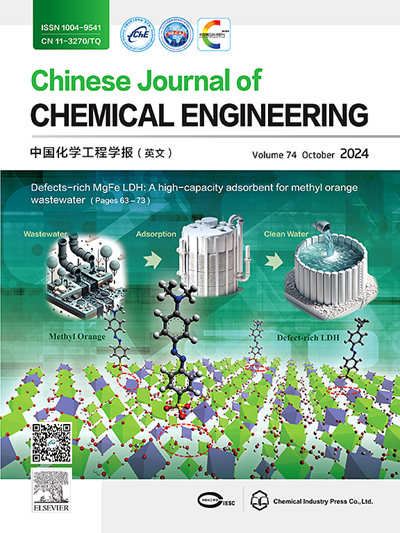Continuous-flow synthesis of pentaerythritol: Alkalinity release of sodium solvation cage to control aldol and cannizzaro reactions
IF 3.7
3区 工程技术
Q2 ENGINEERING, CHEMICAL
引用次数: 0
Abstract
Continuous-flow upgrading of pentaerythritol synthesis technology via base-catalyzed aldol and Cannizzaro reactions of formaldehyde and acetaldehyde faces the challenge of effectively controlling the critical side reaction of hydroxymethyl acetaldehyde (HA) to the acrolein intermediate. Here, we first identified the forms of industrial formaldehyde as methane diol that easily converts to the alkaline formaldehyde under alkaline (NaOH) environment. The carbonyl group of alkaline formaldehyde induces deprotonation of acetaldehyde instead of the recognized base-hydroxyl group-induced deprotonation, and it needs to overcome only 18.31 kcal·mol−1 (1 kcal = 4.186 kJ) energy barrier to form key intermediates of HA. The sodium solvation cage formed by NaOH hexa-coordinated formaldehyde effectively inhibits the alkalinity, thus contributing to a high energy barrier (46.21 kcal·mol−1) to unwanted acrolein formation. In addition, the solvation cage gradually opens to increase the alkalinity with the consumption of formaldehyde, thus facilitating the subsequent Cannizzaro reaction (to overcome 11.77 kcal·mol−1). In comparison, strong alkalinity promotes the formation of acrolein (36.65 kcal·mol−1) to initiate the acetal side reaction, while weak alkalinity reduces the possibility of the Cannizzaro reaction (to overcome 20.44 kcal·mol−1). This theoretically reveals the importance of the segmented feeding of weak and strong bases to successively control the aldol reaction and Cannizzaro reaction, and the combination of Na2CO3 or HCOONa with NaOH improves the pentaerythritol yield by 7%−13% compared to that of NaOH alone (70% yield) within 1 minute at a throughput of 155.7 ml·min-1.

季戊四醇的连续流合成:释放钠溶笼的碱度以控制醛醇和坎尼扎罗反应
碱催化醛醇和甲醛与乙醛的Cannizzaro反应连续流升级季戊四醇合成技术面临着有效控制羟甲基乙醛(HA)对丙烯醛中间体的临界副反应的挑战。在这里,我们首先确定了工业甲醛的形式为甲烷二醇,在碱性(NaOH)环境下容易转化为碱性甲醛。碱性甲醛的羰基诱导乙醛的去质子化,而不是已知的碱基羟基诱导乙醛的去质子化,它只需克服18.31 kcal·mol−1 (1 kcal = 4.186 kJ)能量势垒就能形成HA的关键中间体。氢氧化钠六配位甲醛形成的钠溶剂化笼有效地抑制了碱度,从而形成了一个高能量垒(46.21 kcal·mol−1),阻止了不需要的丙烯醛的形成。另外,随着甲醛的消耗,溶剂化笼逐渐打开,碱度增加,有利于后续的Cannizzaro反应(克服11.77 kcal·mol−1)。相比之下,强碱度促进丙烯醛的生成(36.65 kcal·mol−1)以引发缩醛副反应,而弱碱度降低了Cannizzaro反应的可能性(克服20.44 kcal·mol−1)。这从理论上揭示了弱碱和强碱的分段投料对依次控制醛醇反应和Cannizzaro反应的重要性,Na2CO3或HCOONa与NaOH的组合在1分钟内比NaOH单独(70%收率)提高了7% ~ 13%,吞吐量为155.7 ml·min-1。
本文章由计算机程序翻译,如有差异,请以英文原文为准。
求助全文
约1分钟内获得全文
求助全文
来源期刊

Chinese Journal of Chemical Engineering
工程技术-工程:化工
CiteScore
6.60
自引率
5.30%
发文量
4309
审稿时长
31 days
期刊介绍:
The Chinese Journal of Chemical Engineering (Monthly, started in 1982) is the official journal of the Chemical Industry and Engineering Society of China and published by the Chemical Industry Press Co. Ltd. The aim of the journal is to develop the international exchange of scientific and technical information in the field of chemical engineering. It publishes original research papers that cover the major advancements and achievements in chemical engineering in China as well as some articles from overseas contributors.
The topics of journal include chemical engineering, chemical technology, biochemical engineering, energy and environmental engineering and other relevant fields. Papers are published on the basis of their relevance to theoretical research, practical application or potential uses in the industry as Research Papers, Communications, Reviews and Perspectives. Prominent domestic and overseas chemical experts and scholars have been invited to form an International Advisory Board and the Editorial Committee. It enjoys recognition among Chinese academia and industry as a reliable source of information of what is going on in chemical engineering research, both domestic and abroad.
 求助内容:
求助内容: 应助结果提醒方式:
应助结果提醒方式:


